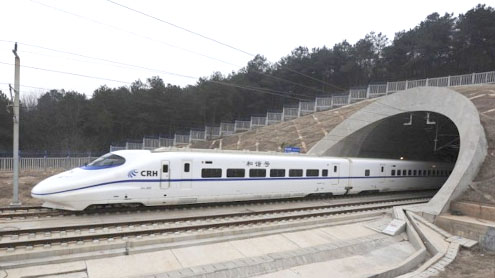 BEIJING: With more high-speed trains set to ply across China, there are concerns that domestic airlines will suffer as a result. The effects are already apparent in parts of China with all flights between Wuhan, capital of Hubei Province, and Nanjing, capital of Jiangsu Province, halted since March 27. The Hefei-Wuhan high-speed line, which opened in 2009, has cut train travel between the two cities from 10 hours to three. Three pairs of China Railway High-Speed (CRH) trains run at 250 km per hour between Wuhan and Nanjing every day. A second-class seat ticket costs 180 yuan (28 U.S. dollars). Previously, two daily flights used to fly between the cities 520 km apart. A full price one-way ticket prised 730 yuan.The high-speed trains are on average more than 90 percent full, while seat occupancy in flights was usually less than 50 percent.Fast expansion of the country’s high-speed rail threatens the future profitability of China’s state-owned airlines, according to annual reports by the country’s major domestic airlines.Analysts expect China’s aviation industry to maintain steady growth this year but will not enjoy record profit growth as it did in 2010 because of more high-speed railway coming into operation and higher fuel prices.
BEIJING: With more high-speed trains set to ply across China, there are concerns that domestic airlines will suffer as a result. The effects are already apparent in parts of China with all flights between Wuhan, capital of Hubei Province, and Nanjing, capital of Jiangsu Province, halted since March 27. The Hefei-Wuhan high-speed line, which opened in 2009, has cut train travel between the two cities from 10 hours to three. Three pairs of China Railway High-Speed (CRH) trains run at 250 km per hour between Wuhan and Nanjing every day. A second-class seat ticket costs 180 yuan (28 U.S. dollars). Previously, two daily flights used to fly between the cities 520 km apart. A full price one-way ticket prised 730 yuan.The high-speed trains are on average more than 90 percent full, while seat occupancy in flights was usually less than 50 percent.Fast expansion of the country’s high-speed rail threatens the future profitability of China’s state-owned airlines, according to annual reports by the country’s major domestic airlines.Analysts expect China’s aviation industry to maintain steady growth this year but will not enjoy record profit growth as it did in 2010 because of more high-speed railway coming into operation and higher fuel prices.
China’s new trains are not only fast but also elegant in comparison with the older. They give passengers a whole new public transport experience which is as comfortable as taking a commercial flight. Taking high-speed trains can be more convenient than flying as China’s railway stations, unlike its airports, are usually located close to the city centers, said Sun Zhang, expert at Shanghai-based Tongji University.It will take almost the same time to travel by high-speed rail between Shanghai and Beijing as by air when time spent on road to and from the airport is factored in, he added.Probably most concerning for airlines is that train tickets are generally cheaper than airline tickets for the same route, especially given the costs of taxis and toll road fees when getting to the airport.No mater how great or small the threat is though, China’s airlines are looking to expand further into an area where high-speed rail can’t compete, namely international travel.
Tan Wangeng, president of China Southern Airlines, said the company will open flights routes between the Chinese mainland and Vancouver and Oakland this year. “The future focus will be on development of flight routes to Europe and the U.S. and international businesses will take up 30 percent of the company’s revenue in the future,” he said.Air China plans to buy 8 to 10 long-haul aircrafts, part of its planned purchase of 30 new planes this year, to step up its expansion into the international market.Liu Shaoyong, chairman of China Eastern Airlines, said Wednesday in New York that the carrier will further its global strategic deployment to continuously strengthen core profitability and step up its exploration of the global market.Aviation expert Wang Jiangmin with the China Southern Airlines said China’s airlines can also expand businesses in the country’s western areas along with the government’s push to develop the less-developed regions.A tremendous demand for fast transport will be unleashed in the western region in the near future, where high-speed railways can not be built easily, he said – APP












